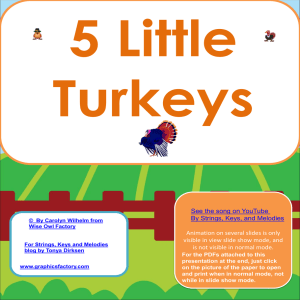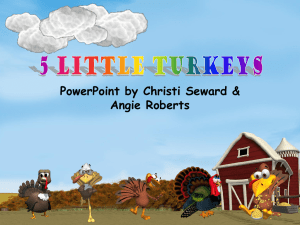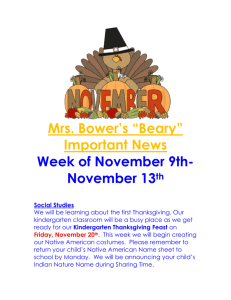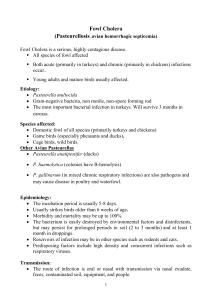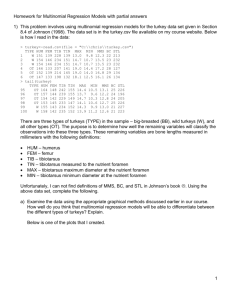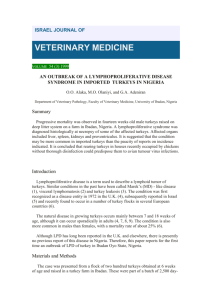turkey care - Farm Sanctuary
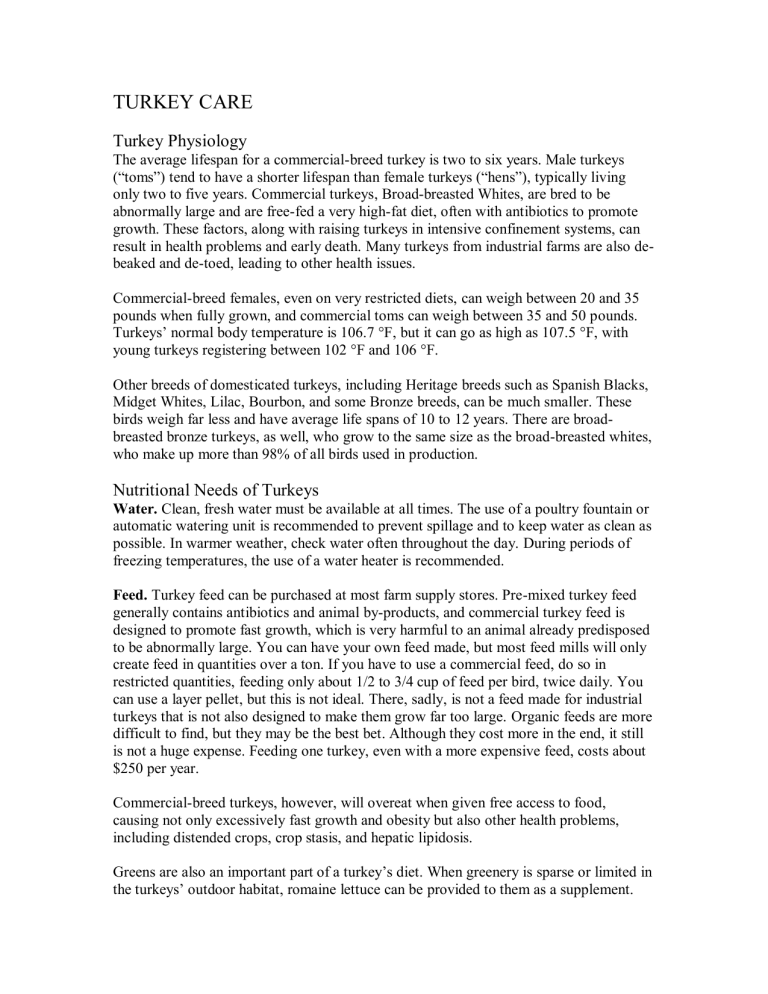
TURKEY CARE
Turkey Physiology
The average lifespan for a commercial-breed turkey is two to six years. Male turkeys
(“toms”) tend to have a shorter lifespan than female turkeys (“hens”), typically living only two to five years. Commercial turkeys, Broad-breasted Whites, are bred to be abnormally large and are free-fed a very high-fat diet, often with antibiotics to promote growth. These factors, along with raising turkeys in intensive confinement systems, can result in health problems and early death. Many turkeys from industrial farms are also debeaked and de-toed, leading to other health issues.
Commercial-breed females, even on very restricted diets, can weigh between 20 and 35 pounds when fully grown, and commercial toms can weigh between 35 and 50 pounds.
Turkeys’ normal body temperature is 106.7 °F, but it can go as high as 107.5 °F, with young turkeys registering between 102 °F and 106 °F.
Other breeds of domesticated turkeys, including Heritage breeds such as Spanish Blacks,
Midget Whites, Lilac, Bourbon, and some Bronze breeds, can be much smaller. These birds weigh far less and have average life spans of 10 to 12 years. There are broadbreasted bronze turkeys, as well, who grow to the same size as the broad-breasted whites, who make up more than 98% of all birds used in production.
Nutritional Needs of Turkeys
Water.
Clean, fresh water must be available at all times. The use of a poultry fountain or automatic watering unit is recommended to prevent spillage and to keep water as clean as possible. In warmer weather, check water often throughout the day. During periods of freezing temperatures, the use of a water heater is recommended.
Feed.
Turkey feed can be purchased at most farm supply stores. Pre-mixed turkey feed generally contains antibiotics and animal by-products, and commercial turkey feed is designed to promote fast growth, which is very harmful to an animal already predisposed to be abnormally large. You can have your own feed made, but most feed mills will only create feed in quantities over a ton. If you have to use a commercial feed, do so in restricted quantities, feeding only about 1/2 to 3/4 cup of feed per bird, twice daily. You can use a layer pellet, but this is not ideal. There, sadly, is not a feed made for industrial turkeys that is not also designed to make them grow far too large. Organic feeds are more difficult to find, but they may be the best bet. Although they cost more in the end, it still is not a huge expense. Feeding one turkey, even with a more expensive feed, costs about
$250 per year.
Commercial-breed turkeys, however, will overeat when given free access to food, causing not only excessively fast growth and obesity but also other health problems, including distended crops, crop stasis, and hepatic lipidosis.
Greens are also an important part of a turkey’s diet. When greenery is sparse or limited in the turkeys’ outdoor habitat, romaine lettuce can be provided to them as a supplement.
When they are being supplemented, the pelleted food can be reduced only slightly (use
3/4 cup rather than 1 cup) to keep the weight off. Weighing turkeys once a month will ensure they are not growing too large.
Feeders.
Turkeys, particularly ones who have been debeaked, may have trouble eating food off the ground or eating smaller grains. Additionally, eating off the ground increases the risk of parasite infestations. Choose a feed container that is heavy enough to prevent tipping and small enough to prevent birds from walking or standing in their feed as this can lead to contamination by feces. Special poultry feeders are available through farm and feed supply stores and catalogs.
Handling Turkeys
Due to the excessive weight turkeys reach when grown, their legs can be damaged easily.
Therefore, turkeys should never be grabbed or picked up by their legs (a common industry practice). To pick up a turkey, stand behind the turkey, fold your arms and upper body over her wings and back, hug firmly, and lift. If you “lose” a wing, put the bird down immediately and start over. Handle firmly but gently to avoid injuring the turkey or yourself. If your turkey is struggling or seems to be highly stressed, set her down for a moment and start again. Covering the bird’s head and eyes with your free hand may calm her. If you have never handled an adult turkey, do not attempt to do so alone and have someone with training demonstrate this for you. The turkey can panic and easily injure herself or the handler.
Shelter Requirements for Turkeys
Building.
A garage or shed makes a fine turkey home. A good size is 10 feet by 20 feet because this is high enough for you to walk comfortably inside. The shelter must be waterproof, predator-proof, and well ventilated. A wooden floor is best for cleaning purposes, but, because turkeys can easily slip on wood, we recommend covering wood floors with rubber mats or some other slip-resistant material. Because turkeys are prone to leg and joint issues, plenty of clean, dry straw or wood shavings should always be provided for bedding. Short fiber straw is also better so that they do not get tangled in the bedding. Wet and soiled bedding should be removed daily. Cleaning the entire building
(i.e., scrubbing floors, walls, etc.) once a week is recommended. The very best flooring for a turkey is dirt, but many predators dig under barns to get inside, so if you are using a dirt floor, make sure that predators, including rats, cannot dig under and get to your turkeys.
For protection from predators, turkeys must be kept safely in their shelter at night. Rats must be kept out of the shelter because large and de-toed commercial turkeys cannot perch and are therefore vulnerable to them.
If you have non-commercial turkeys or young commercial turkeys still able to perch, the shelter should be equipped with a roost. For those who cannot roost, an unopened straw bale makes a good alternative sleeping station. Each female turkey must also be provided with a nesting box, which easily can be made out of straw bales or constructed of wood.
Make sure whatever material you use is stable and can safely hold their weight and that there are no gaps where they can get a foot stuck.
Fencing.
Fencing is necessary to keep predators out and turkeys in. A 4- to 5-foot-high fence is adequate for turkeys of commercial breeds, most of whom are too heavy to fly. If you have noncommercial breeds, however, you may need to trim their wings or erect a fence higher than 6 feet. Wing trimming is painless because only feathers are being cut, but it needs to be done correctly, so it is best to be trained by your vet or someone with experience. Heritage breed turkeys can fly to the tops of trees or even three-story homes, so it will probably be necessary to trim their wings to keep them safe.
If you are planning to construct a fence, shop around for the best buy because prices and styles of fencing vary greatly. Turkey fencing can be purchased from your local farm supply or lumber store or through a farm supply catalog (see resource list). Do not use chicken wire alone as fencing. It is too flimsy, and predators can easily break through it.
We recommend woven wire “no climb” fence stretched tightly and reaching to the ground. For areas with foxes or other digging predators, we recommend using a fence that is taller than needed to contain the birds so that the excess inches can be bent and buried to prevent digging; alternately, you can dig a trench and sink the fence.
Health Care for Turkeys
Maintenance.
For turkeys, as for all animals, sanitary housing, clean pasture, nutritious food, and plenty of sunshine will greatly reduce health problems. Living in small flocks also reduces turkeys’ vulnerability to health problems (living in large flocks, on the other hand, tends to lower the birds’ disease tolerance and allows the spread of disease).
Like dogs or cats, turkeys need to have their toenails clipped (unless they are de-toed), especially if they are not very mobile. Trimming turkeys’ nails is very similar to trimming dogs’ or cats’ nails; your veterinarian can show you this procedure.
During your daily contact with your birds, always be on the lookout for any physical or behavioral changes. In particular, watch for diarrhea, listlessness, pale coloring, loss of appetite, limping or other gait changes, swollen sinuses (just below the eyes), bubbly eyes or discharge, sneezing, or coughing. If you notice any of these symptoms, consult your veterinarian. It can be difficult to find a veterinarian who is willing to treat turkeys, but they do exist. Your best bet is to find someone who works with “exotic” birds and other non-traditional companion animals.
Common Health Issues of Turkeys
Bumblefoot.
Bumblefoot is indicated by the presence of a scab on the foot. Typically, when the scab is removed, thick yellow pus and dead tissue are present. The foot can be soaked in Epsom salts and the infected area flushed with dilute Betadine or
Chlorhexidine or scrubbed clean with a wound cleaner and rinsed with saline or sterile water. There are various causes of bumble foot in turkeys, so make sure you are positive of the cause to ensure proper treatment.
There are many alternatives to treatment for bumblefoot in turkeys based on the type: infectious or noninfectious. If infection is present, we recommend having the pus or discharge cultured to ensure you are using the proper antibiotics for treatment. This would be an oral or injectable antibiotic in addition to cleaning and wrapping the foot and using a topical treatment directly on the infected area. Turkeys often experience swelling of the digits and pads when no infection is present, and, in such cases, the use of a nonsteroidal anti-inflammatory drug (NSAID) is needed rather than antibiotics. It is important to diagnose the exact cause of the problem before treating.
The wrapping procedure may need to be repeated for three to four weeks, or even longer, if infection continues or the sore is not healed. Many cases of bumblefoot in turkeys start because pressure sores on the soles of the feet caused by excess weight or improper weight distribution put pressure on the wrong part of the foot when the turkey is walking.
Dry wrapping for pressure sores is a good idea and allows sores to heal before infection occurs. The outer layers of wraps should always be kept dry in inclement weather. Even if there is heavy dew, turkeys should be kept off the grass and possibly isolated during the time they are wrapped. They can go outside if the area they are in is dry. If you have never done a foot wrap, make sure a vet or someone experienced teaches you because an improperly administered wrap can cause permanent damage to the foot.
Lice and Mites.
Generally lice and mites can be controlled by providing your turkeys with an area of dirt for “dust baths” (throwing dirt on themselves); this area must be kept clean and dry. Check your turkeys regularly for lice and mites and also watch for excessive scratching or rubbing. Mites look like small black dots and leave an area in the feathers that is greasy and resembles a mass of dirt; lice are clear or yellow. Lice powders are available at farm supply stores. Flea spray or diatomaceous earth powder (available at garden stores) may also be used. If you have a mite infestation, you need to remove all bedding, bales, etc., and treat the barns because mites can live outside the host for well over three months. Mites can be very difficult to get rid of, and special types of dust are required to eradicate them. Consult your vet if you have a mite outbreak, and remember that the mites can spread from you to all the other birds in your care, so you may have to isolate any individuals with mites from other birds.
Internal Parasites.
Internal parasites can be problematic for turkeys. We recommend having a fecal sample analyzed by a lab when birds first arrive and two to three times a year thereafter. The results will determine what worming medication is appropriate for your flock. Wormers can be purchased at farm supply stores in easy-to-use formulas that are added to drinking water, but some types of parasites require individual treatments.
Loss of weight, greatly increased feed consumption, poor feather condition, gaping or gasping for air, lethargy, diarrhea, black stools, and bloody stools are some of the signs of parasite infestations.
Coccidiosis.
Coccidiosis is a protozoan parasite. Symptoms include bloody diarrhea and listlessness. Keeping the bedding clean and dry will help control this disease, as wet bedding is one of the predisposing factors. If you suspect your turkey has this disease,
consult your veterinarian for confirmation. Most treatments are administered via drinking water, so whole flocks can be treated at the same time.
Gape Worm or Trachea Worms.
The gapeworm is a round, red worm that attaches to the trachea of the bird and causes him to breathe with an open mouth or appear to be gasping or gaping for air. These parasites are often seen in young turkeys. Because they can inhibit breathing, they can be fatal. Early detection is key. If the infestation is heavy enough, the bird can die after treatment starts because dead parasites also can close off the trachea. This is why it is so important to conduct routine fecal examinations and to isolate incoming birds.
Round Worms.
These are one of the most common parasites in turkeys and chickens.
The adult worms are about an inch to an inch-and-a-half long and can easily be seen in the feces. If the birds develop a heavy infestation, they will become lethargic, go off their feed, and have diarrhea. Severe infestations can lead to death. Also refer to the discussion of black head disease (below), which is related.
Molting.
Turkeys will molt (lose feathers) annually, generally during the spring or fall seasons. During their molting period, the birds may lose a large portion of their feathers.
This natural process lasts between four and ten weeks. If your turkey is losing feathers during a non-molting period, consult your veterinarian. Birds can also act “off” or be slightly lethargic during a molt.
Heat Exhaustion.
Heat exhaustion is common in turkeys, so watch them closely in hot weather and ensure that their barns have proper ventilation and cooling equipment. Signs of heat exhaustion include excessive panting, drooping, dark-colored head, and collapse.
At first sign of heat exhaustion, get the turkey inside immediately, put a fan on low, mist the bird lightly with cool water, and contact your veterinarian. Keep the bird quiet and calm and handle no more than necessary.
Upper Respiratory Infections.
Upper respiratory infections are usually indicated by the presence of nasal discharge, lethargy, snuffly or gurgly breathing sounds, swollen sinus areas (under the eye), open mouth breathing and loss of appetite. These infections, common during seasonal shifts in climate, can be easily treated with antibiotics in the turkeys’ drinking water. Turkeys do sometimes develop more serious upper respiratory infections, so if basic treatments are ineffective, consult with your veterinarian.
Mycoplasma is common in turkeys and requires a more aggressive treatment, usually a water treatment along with an oral medication administered individually.
Mycoplasma Infections.
Turkeys are susceptible to two forms of this disease, called the
“upper form” and the “lower form.” In birds afflicted with the upper form, the eyes and nostrils become watery, the sinus area below the eyes becomes swollen, and the exudate
(pus or mucus) becomes caseous (cheesy) and firm. The birds are gurgly and lethargic, and the pus from the eyes and nostrils smells of infection. The eyes are often swollen shut and have to be opened by applying a warm, wet cloth to allow the pus to drain. The lower form develops in the air sacs and leads to airsacculitis. Although birds infected with this
form develop lesions throughout their air sacs, they may not show outwards signs of infection at first. They become weak and lethargic but do not necessarily show signs of straining to breathe until they are dying. Both forms can be treated with antibiotics, usually a combination of at least two drugs. Turkeys can carry mycoplasma for life and often have chronic infections that can be difficult to treat. Without treatment, mycoplasma infections are often fatal.
Blackhead.
Blackhead disease, or histomoniasis, is primarily a disease of young turkeys.
Chickens seem to be resistant to the effects of the infection, but they can be carriers.
Histomoniasis is caused by a microscopic protozoan called Histomonas meleagridis . The protozoan causes considerable damage to the liver and ceca of infected turkeys and is usually fatal if untreated. Mustard-colored droppings are a symptom, as are weakness and loss of appetite. The disease is treated with Metronidazole, which can be obtained from your veterinarian. Because of the risk of infection, we recommend waiting until turkeys are at least six months old before putting them with chickens.
Sour Crop or Crop Stasis.
In crop stasis, the crop, which is a diverticulum of the esophagus, stops emptying and becomes distended with fermenting food and fluids. This condition can require multiple treatments, including the use of probiotics, antifungals, or antibiotics, depending on the cause. Without treatment, the bird can starve to death or aspirate when feed goes into the windpipe instead of the stomach.
Impacted Crop.
The crop, especially in commercial birds, can become impacted with grass, straw, feathers, or other debris and prevent food from passing. The crop may become too distended to function, in which case surgery may be required to reduce or remove the crop completely. In most cases, impacted crops can be easily identified by looking at the crop areas of all the birds before morning feeds. If any of the birds have a full crop at this time, it is important to identify the cause immediately.
Males and Females Together.
We discourage housing commercial-breed male and female turkeys together. The males of this breed are so excessively large that, when a male mounts a female, he may tear her skin down to the muscle. This type of tissue damage often requires surgery and suturing, and, because of the turkeys’ size, the sutures often open, necessitating treatment of the wounds for months before they heal properly.
Mounting can also damage the ligaments, neck, spine, and legs of the females, due both to the size of the males and commercial turkeys’ predisposition to joint and leg problems.
Because of their size, commercial-breed turkeys cannot mate naturally. In the industry, reproduction occurs through artificial insemination.
Joint/Keel Infections.
Turkeys often develop leg joint infections from being down on their hocks for a majority of the day, either because they are overweight or because they have joint pain or arthritis. The keel or breast bone in turkeys is also an area that is prone to these types of pressure sores. The contact and pressure from the ground causes the formation of scabs or sores, and these can develop into wounds through which bacteria can enter. Usually wraps and antibiotics are necessary to treat this type of infection and, if it is not treated, the infection often spreads to the bone and requires surgery or cannot
be treated. Checking these areas routinely on your birds is the best way to prevent this condition. Providing heavy bedding if there is a sign of keel or joint sores is also important.
These are just a few of the more common problems affecting turkeys. We advise that you consult your veterinarian whenever your turkey exhibits any unusual behavior or symptoms.
Incoming Bird Procedures
When birds arrive, they must be isolated in a strict quarantine area, and caretakers should wear coveralls and boot covers. If animals are in really bad shape, do not spread straw on your existing pastures. Instead, pile it in a separate area on the farm until any testing required is completed. If birds have signs of mouth or facial sores, nasal discharge, or respiratory disease, also use rubber gloves when handling anything they come into contact with. If you are aware that birds will be coming to the shelter, they must be tested prior to arrival and accompanied by proper paperwork. It is illegal to bring animals across state lines without proper testing.
If a birds are dropped off and you have no idea of their origin, they must be taken immediately to the bird quarantine area and kept away from all other birds; do not allow even beak-to-beak contact.
Birds should have a complete health check performed using all isolation procedures, including suits, boots, and rubber gloves.
If animals are sick, they should be diagnosed by a vet and immediately started on treatments. If a contagious disease is present, you may need to report it, and you may need to adjust your cleaning procedures.
If the animals seem healthy, perform full body checks and send in fecal samples.
Check for lice and mites. If the birds are healthy enough to withstand treatment, use injectable Ivomec and either lice dust or spray depending on the temperature.
All birds must remain in quarantine for at least 30 days and until all necessary blood work is complete and fecal exams come back negative to ensure your resident flock is not exposed to health issues.
If birds are laying eggs, the eggs must be composted with their straw/bedding until you are sure that the animals are not sick.
Turkey Behavior Issues:
Turkeys are flock animals and thrive best in groups. Turkeys are also territorial, however, so you must keep this in mind when you introduce birds to each other. Male turkeys, or
Toms, can be very aggressive with each other and should be introduced only when mating season is over — in the fall or, preferably, in winter, to be safe. They may still fight, so you will need to be present to break up fights and ensure that no bird is severely injured, although they usually work out dominance quickly. Do not introduce birds in hot weather because this is likely to exacerbate problems.
Female turkeys also fight, so, again, be available to stay with the birds when they are first introduced. Turkeys may also be aggressive with new chickens or other bird residents who are being introduced, so always be vigilant.
If your males cannot live together without fighting, we have found that they do well with large-breed roosters and can be good companions for them. Turkeys would, of course, prefer to be with other turkeys when possible.
Resources for Turkey Care
Please note: Many of the catalogs listed contain products commonly used in animal agriculture. Unfortunately, there are no farm catalogs that list only cruelty-free items at this time:
Omaha Vaccine Company: PO Box 7228, Omaha, NE 68107; phone: 800-367-4444
Nasco Farm & Ranch: 901 Janesville Ave., Fort Atkinson, WI 53538-0901; phone: 800-
558-9595
Valley Vet Supply: PO Box 504, Marysville, KS 66508; phone: 800-468-0059

